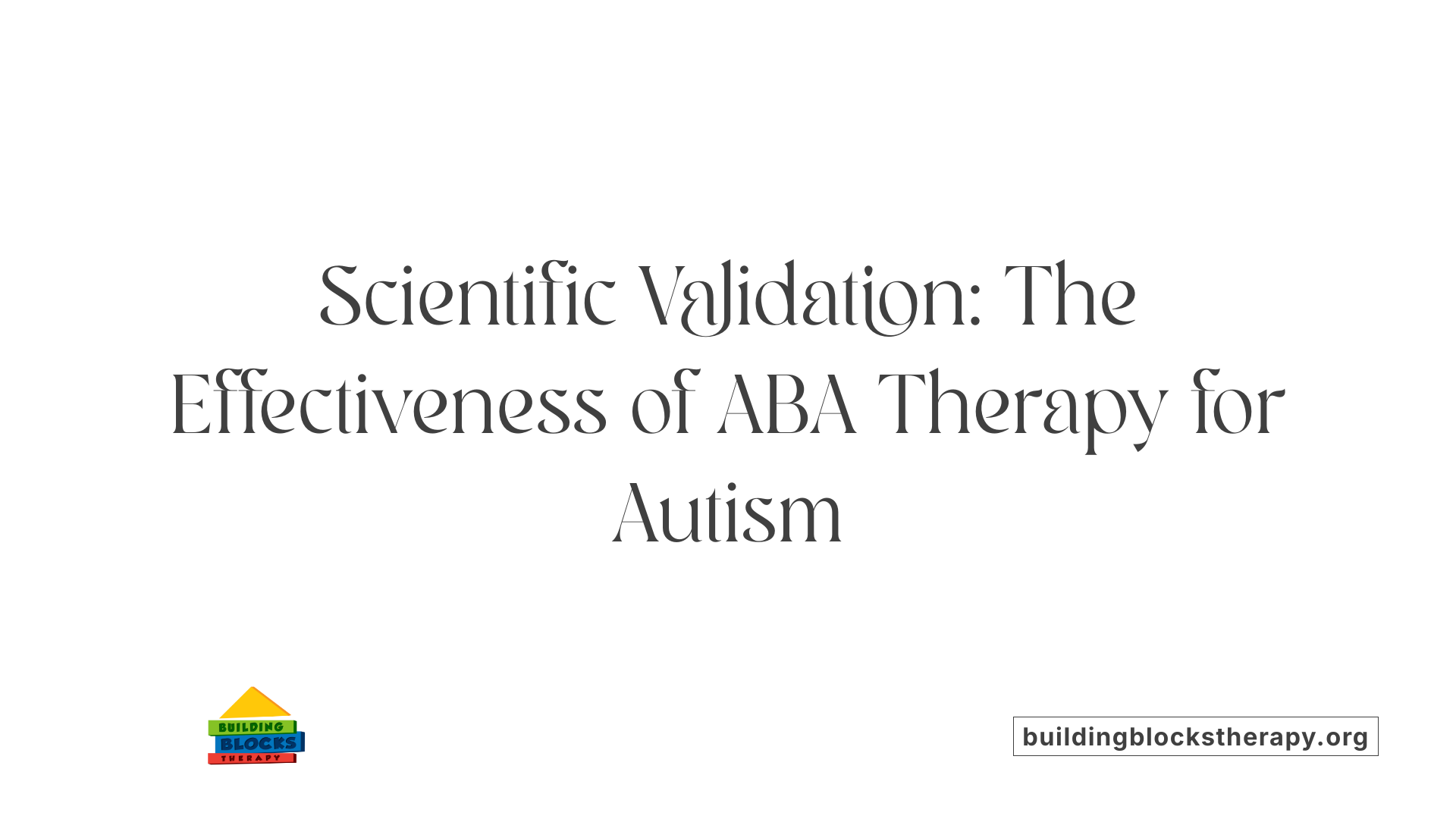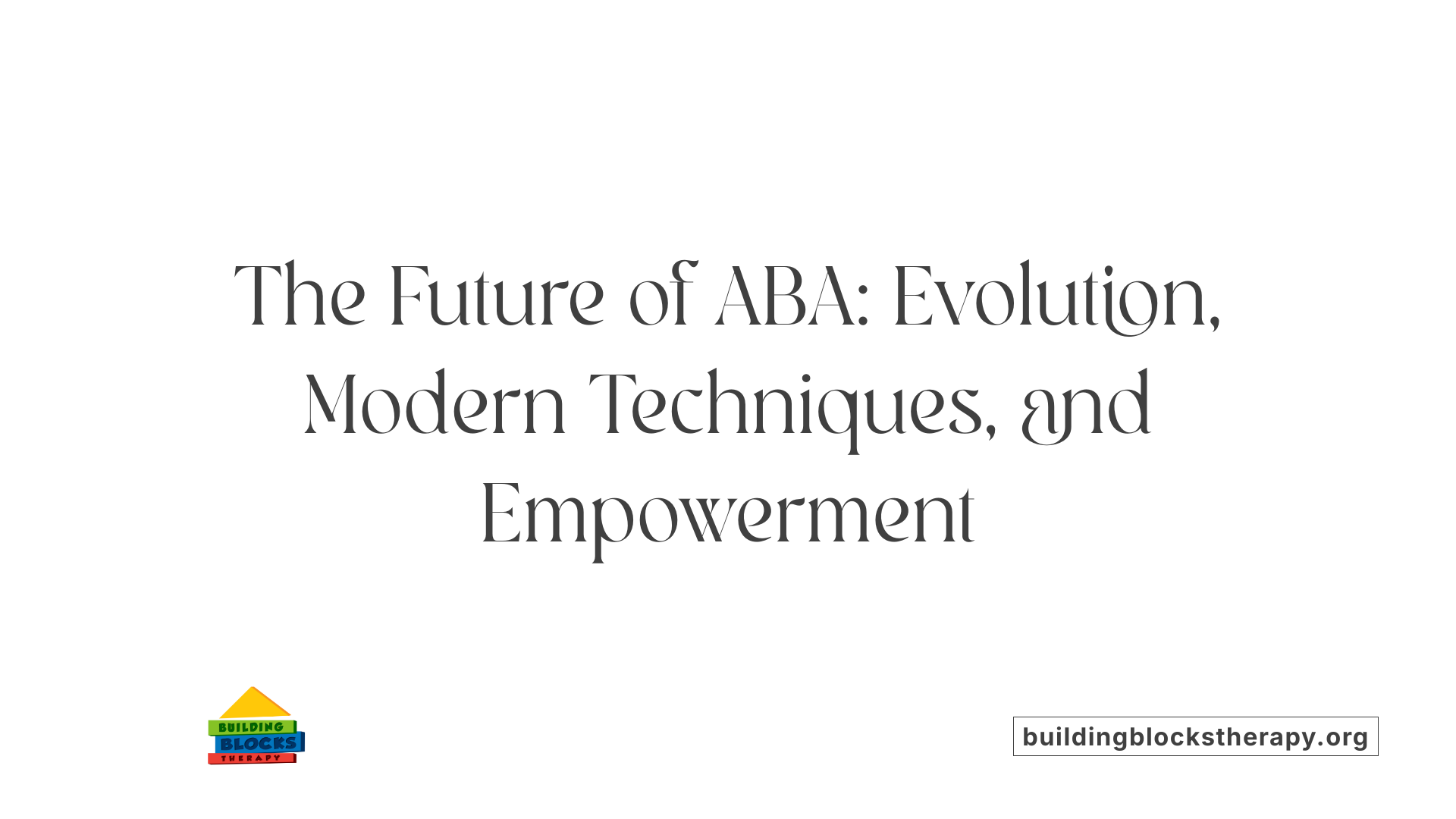How Applied Behavior Analysis (ABA) Therapy Helps Children with Autism
Transforming Lives: The Impact of ABA Therapy on Children with Autism

Understanding ABA Therapy and Its Role in Autism Support
Applied Behavior Analysis (ABA) therapy is a scientifically supported method designed to help children with autism spectrum disorder (ASD) develop essential skills and reduce challenging behaviors. By applying principles of learning and behavior, ABA offers individualized treatment plans that promote communication, social interaction, and independence, allowing children to thrive in various aspects of life. This article delves into how ABA therapy works, the benefits it provides, and important considerations for families and professionals involved in autism care.
What is Applied Behavior Analysis (ABA) Therapy?

What is Applied Behavior Analysis (ABA) therapy and how is it used to support individuals with autism?
Applied Behavior Analysis (ABA) therapy is a science-based approach to understanding behavior and how it is influenced by environmental factors. It aims to increase positive and helpful behaviors such as communication, social skills, attention, and daily living activities, while decreasing challenging or harmful behaviors.
ABA is widely used to support children and adults with autism spectrum disorder (ASD). It applies learning principles like positive reinforcement—where rewards follow desired behaviors—to help individuals develop essential skills. ABA programs break down complex skills into smaller, manageable steps and tailor interventions to each individual's strengths and needs.
Settings and delivery methods
ABA therapy is flexible and can be provided in various environments, including the home, school, or community settings. It may involve one-on-one sessions or group interactions, using different instructional methods such as Discrete Trial Training (structured tasks) and Pivotal Response Treatment (play-based, naturalistic learning).
Role of a Board Certified Behavior Analyst (BCBA)
A qualified BCBA oversees ABA programs by conducting detailed assessments, creating personalized treatment plans, and regularly measuring progress. Their expertise ensures that each ABA intervention targets meaningful behaviors and adapts over time to meet the individual's evolving needs.
Evidence supporting ABA's effectiveness
Numerous studies and major health organizations, including the US Surgeon General and the American Psychological Association, recognize ABA as an effective treatment for autism. Research shows that early and intensive ABA therapy can significantly improve language, social skills, adaptive behavior, and emotional regulation in children with ASD.
These improvements help individuals gain independence and better engage with their communities. While individual outcomes vary, ABA's evidence-based methods remain the most validated behavioral treatment available for autism.
Key Benefits and Goals of ABA Therapy for Children with Autism

What are the key benefits and goals of ABA therapy for individuals on the autism spectrum?
Applied Behavior Analysis (ABA) therapy delivers important benefits for children with autism, focusing on improving communication, social skills, and independence. One primary goal is to increase positive and adaptive behaviors like effective communication and social interaction. ABA helps children learn essential life skills such as personal hygiene, grooming, and self-care, enabling greater daily functioning.
ABA also plays a vital role in reducing harmful or interfering behaviors. Through techniques like positive reinforcement and natural environment training, ABA encourages behaviors that help children better cope with emotions and develop healthy social bonds. This foundation supports enhanced participation in social activities and friendships.
The therapy is highly individualized, allowing treatment plans to be tailored to each child’s strengths and interests. Early and intensive intervention using ABA methods has been shown to yield remarkable improvements in expressive language, socialization, and emotional regulation.
Beyond immediate skill gains, ABA supports long-term goals of independence and community integration. Children gain tools to manage behavior, understand social cues, and make choices, fostering lifelong self-sufficiency and quality of life.
By using scientifically validated strategies crafted by board-certified behavior analysts, ABA therapy empowers children with autism to develop communication, social, and daily living skills that open pathways to fuller participation in family and community life.
Who Provides ABA Therapy and Their Qualifications

Typical professionals involved in ABA therapy
ABA therapy is primarily provided by trained professionals including Board-Certified Behavior Analysts (BCBAs), Registered Behavior Technicians (RBTs), and licensed therapists. Each plays a vital role in delivering and supporting ABA interventions tailored to individual client needs.
Educational background and certifications
Providers typically hold degrees in fields like psychology, education, or behavior analysis. BCBAs usually have at least a master's degree in behavior analysis or a closely related field and must pass a rigorous certification exam administered by the Behavior Analyst Certification Board (BACB).
Role and training of BCBAs and RBTs
BCBAs design and oversee ABA programs, conduct detailed assessments, create individualized treatment plans, and monitor ongoing progress. In contrast, RBTs work under BCBA supervision delivering one-on-one therapy, implementing intervention plans, and collecting data on client behavior.
Both BCBAs and RBTs complete supervised practical experience involving direct client interactions and data collection to ensure adherence to behavioral principles. This hands-on training is crucial for developing skills necessary for effective therapy delivery.
Ethical standards and continuous professional development
ABA providers adhere to strict ethical guidelines set forth by the BACB, which emphasize client welfare, confidentiality, and professionalism. Additionally, continuous professional development is required to maintain certification, ensuring providers stay current with advances in ABA methodologies and best practices.
Together, these qualifications and training ensure ABA therapy is delivered safely, effectively, and respectfully, supporting meaningful behavioral change and improved quality of life for individuals receiving treatment.
Customizing ABA Therapy to Meet Individual Needs
How is ABA therapy tailored to meet the individual needs of each person with autism?
ABA therapy begins with detailed assessments conducted by a Board-Certified Behavior Analyst (BCBA) to identify each individual's unique strengths, challenges, and developmental goals. This comprehensive evaluation informs the creation of a personalized treatment plan designed specifically to address the person's needs.
Therapy sessions involve breaking down complex skills—such as communication, social interaction, self-care, and academics—into smaller, manageable steps. This stepwise approach helps learners acquire new skills more effectively by gradually building upon mastered behaviors.
Progress is carefully monitored through ongoing data collection, allowing therapists to adjust the treatment plan regularly to ensure it remains effective and relevant over time. This dynamic process helps accommodate changes in the learner's abilities and environment.
Parent involvement and coaching are essential components of individualized ABA programs. By training caregivers in ABA principles and strategies, families can consistently support skill development at home and in natural settings, enhancing generalization and long-term success.
ABA also emphasizes leveraging the learner's interests and strengths, making sessions enjoyable and engaging. This tailored focus not only increases motivation but also respects the individual's unique personality, fostering independence and social integration.
Techniques and Strategies Employed in ABA Therapy
What techniques and strategies are commonly employed in ABA therapy sessions?
Applied Behavior Analysis (ABA) therapy uses a variety of structured approaches to teach new skills and improve behavior in individuals with autism spectrum disorder (ASD). Among the most common methods is Discrete Trial Training (DTT), which breaks down skills into small, manageable steps presented in repetitive, one-on-one sessions. DTT focuses on clear instructions, prompts, and immediate rewards to reinforce correct responses.
Pivotal Response Treatment (PRT) takes a more naturalistic approach, using the child’s interests to encourage motivation and engagement. It occurs in less structured settings, promoting pivotal skills like initiating communication and self-management through play and everyday activities.
Another comprehensive method is the Early Start Denver Model (ESDM), designed for children aged 12 to 48 months. ESDM integrates ABA principles with developmental and relationship-based approaches to improve language, social, and cognitive skills primarily through play and shared activities.
A core strategy across these techniques is the use of positive reinforcement—providing desirable rewards or praise immediately after desired behaviors to increase the likelihood they will recur. Prompting and fading techniques help learners gradually improve independence by initially providing cues and then slowly reducing them.
Natural environment training and group activities are often included to generalize skills beyond structured settings, fostering social interaction and real-life application. Behavioral interventions such as extinction (ignoring harmful behaviors to decrease them) and redirection (guiding attention away from inappropriate behaviors) are also utilized to support behavior change.
Together, these evidence-based strategies enable ABA therapy to be highly individualized, adaptable, and effective in teaching communication, social, emotional, and daily living skills while managing challenging behaviors.
Family and Caregiver Involvement in ABA Therapy
How can families and caregivers be involved in ABA therapy to support ongoing progress?
Families and caregivers play a crucial role in the success of ABA therapy by actively participating throughout the treatment process. One important way they can contribute is through training provided by Board-Certified Behavior Analysts (BCBAs) or therapists. This training equips caregivers with the skills and knowledge to implement ABA strategies consistently across home and community settings, which helps maintain progress between formal sessions.
Consistency is essential in ABA therapy. When caregivers apply behavioral techniques during daily routines such as mealtime, playtime, or self-care activities, it promotes generalization of skills learned in therapy. The involvement of caregivers in goal setting ensures that the interventions address meaningful, real-world skills tailored to the child’s interests and family priorities.
Collaboration between caregivers and therapists is fostered through regular communication. This partnership allows caregivers to provide feedback, attend therapy sessions, and receive coaching on implementing naturalistic interventions. Techniques like Pivotal Response Treatment (PRT), which are play-based and focus on the child’s motivations, encourage caregivers to engage children in social-communication growth during everyday interactions.
Benefits of caregiver involvement include improved skill retention in children, lessening of challenging behaviors, and strengthening emotional connections within the family. Engaged caregivers can better support emotional regulation and coping strategies that children learn during therapy. Overall, caregiver participation enhances the effectiveness of ABA by making interventions more consistent, personalized, and enjoyable for the child.
Scientific Evidence Supporting ABA Therapy

What evidence exists regarding the effectiveness of ABA therapy for autism?
Extensive scientific research supports Applied Behavior Analysis (ABA) therapy as an effective intervention for children with autism spectrum disorder (ASD). Meta-analyses combining multiple studies reveal that ABA leads to significant improvements in several developmental domains.
Meta-analyses and research findings
Meta-analyses of 29 studies have shown large effect sizes for intellectual abilities (g=0.740) and moderate to high improvements in communication (g=0.650), expressive language (g=0.742), and receptive language (g=0.597). Socialization and overall adaptive behaviors also improve moderately (effect sizes around g=0.4). These results are drawn from studies using various ABA intervention models such as Discrete Trial Training (DTT), Pivotal Response Treatment (PRT), and the Early Start Denver Model (ESDM).
Improvements in IQ, language, social skills
Children receiving ABA show enhancements in IQ scores, social skills, communication abilities, and emotional regulation. For example, studies employing structured assessments like the Kindergarten Inventory of Social/Emotional Tendencies (KIST) report improvements in adaptive behaviors and reductions in problem behaviors such as separation anxiety.
Limitations related to core ASD symptoms
Although ABA demonstrates gains in many developmental areas, its effect on core autism symptoms—such as repetitive behaviors—is limited. Improvements in daily living skills have been reported as small (effect size g=0.138), and evidence remains inconclusive on the impact of ABA on some ASD-specific traits.
Effect of therapy intensity and duration
While intensive ABA (20-40 hours per week) is common, research does not always show a direct correlation between higher intensity and better outcomes. Optimal therapy dosage varies per individual, with many programs tailoring frequency and duration to personal needs.
Need for long-term quality of life studies
Most ABA studies are small, short-term, and focused on specific skill mastery. There is a noteworthy lack of long-term research evaluating quality of life outcomes and social participation over time. Experts emphasize the need for large-scale prospective studies comparing ABA to other interventions and tracking lifelong well-being.
| Area of Improvement | Effect Size (g) | Remarks |
|---|---|---|
| Intellectual Abilities | 0.740 | Large positive effect observed in multiple studies |
| Expressive Language | 0.742 | Significant gains in language skills |
| Receptive Language | 0.597 | Moderate improvements noted |
| Socialization | 0.444 | Moderate improvement, important for real-world functioning |
| Adaptive Behavior | 0.422 | Moderate gains in daily adaptive skills |
| Daily Living Skills | 0.138 | Small effect size, indicating limited impact |
Overall, current scientific evidence validates ABA as a well-supported treatment that enhances communication, socialization, and cognitive skills in children with ASD, while ongoing research continues to investigate its broader, long-term effects.
Ethical Considerations in Delivering ABA Therapy
What ethical considerations should be taken into account when providing ABA therapy?
Delivering Applied Behavior Analysis (ABA) therapy demands strict ethical attention to uphold the dignity and autonomy of clients. Practitioners must ensure informed consent is obtained, clearly explaining therapy goals and methods to the client or their guardians. Maintaining professional boundaries is essential to avoid conflicts of interest, establishing trust and a safe therapeutic environment.
ABA providers are guided by ethical codes such as those from the Behavior Analyst Certification Board (BACB) and the Association for Behavior Analysis International (ABAI). These emphasize beneficence—doing good; respect for client preferences; integrity in reporting and assessment; and competence, ensuring therapists are properly trained to deliver effective interventions.
Cultural sensitivity and bias awareness are critical components, requiring providers to recognize and respect diverse backgrounds, beliefs, and values. This approach helps tailor therapy that honors individual identities and avoids harm from misunderstandings or inappropriate practices.
Promoting equitable access is also an ethical imperative. ABA therapy can be resource-intensive, so therapists often incorporate group-based interventions or work closely with families to maximize reach and effectiveness. Family involvement not only supports generalization of skills across settings but also empowers caregivers to participate meaningfully in treatment decisions.
Continuous monitoring of intervention fidelity and assessing treatment outcomes guarantee that ABA services remain ethical by ensuring interventions produce meaningful, quality improvements. This safeguards participants against ineffective or harmful procedures, aligning therapeutic efforts with the best interests of those served.
ABA Therapy’s Role in Developing Life and Social Skills
Teaching essential daily living skills
ABA therapy focuses on helping children acquire crucial life skills such as personal hygiene, grooming, and self-care behaviors. These skills are broken down into manageable steps and taught using positive reinforcement methods, making it easier for children to learn and adopt them into daily routines.
Promoting social communication and friendships
One of the important goals of ABA is to enhance social communication. Techniques like natural environment training and group activities encourage children to engage with peers, improving their ability to initiate and maintain conversations. This process helps children with autism build friendships and feel more connected socially.
Coping with emotions through ABA
ABA incorporates strategies to help children manage their emotions effectively. By teaching healthy coping mechanisms and utilizing play therapy, children learn to regulate their feelings. This emotional development is vital for reducing anxiety and improving overall well-being.
Preparing children for real-world interactions
ABA prepares children to navigate social settings by teaching them to recognize and understand social cues. Behavioral management skills are developed to help children adapt and respond appropriately in various situations, enhancing their confidence and societal participation.
Building independence and enjoyment in learning
The therapy is highly individualized and tailored to the child's interests and strengths, making learning enjoyable. ABA promotes independence by encouraging children to make choices and engage actively in their learning experiences, fostering a positive and motivating environment.
| Aspect | Focus Area | ABA Techniques Used |
|---|---|---|
| Daily Living Skills | Hygiene, grooming, self-care | Task breakdown, positive reinforcement |
| Social Communication | Friendships, interaction | Natural environment training, group activities |
| Emotional Coping | Emotion regulation | Play therapy, healthy coping strategies |
| Real-World Preparation | Social cues, behavior management | Social skills training, behavioral expectations teaching |
| Independence & Enjoyment | Motivation, choice-making | Individualized sessions, interest-based reinforcement |
The Evolution and Modern Practices of ABA Therapy

Historical context and development since 1960s
Applied Behavior Analysis (ABA) therapy has its roots in the 1960s, originating as a scientific approach grounded in behavioral principles and operant conditioning. Over the decades, it has evolved significantly, initially focused on structured, often rigid techniques such as Discrete Trial Training (DTT) that aimed to modify behaviors through systematic reinforcement.
Contemporary focus on fun, engagement, and neurodiversity respect
Modern ABA embraces a shift toward making learning enjoyable and engaging rather than repetitive or punitive. This contemporary focus respects neurodiversity by emphasizing empowerment rather than forcing conformity to neurotypical norms. The therapy encourages choice and positive experiences, recognizing the individuality and unique strengths of each child.
Integration of play-based, naturalistic methods
In recent years, play-based and naturalistic methods like the Early Start Denver Model (ESDM) and Pivotal Response Training (PRT) have been integrated into ABA practice. These approaches use the child's interests and natural environments to promote skill development, making therapy less intrusive and more relatable to real-world scenarios.
Reduction of rigid or punishment-based methods
Traditional punishment-based or overly rigid protocols have largely been replaced by positive reinforcement strategies. Contemporary ABA focuses on reinforcing desired behaviors through rewards and praise, fostering a supportive learning environment that encourages social interaction and communication without coercion.
Moving towards quality of life and empowerment goals
The scope of ABA now extends beyond just skill acquisition and behavior reduction. Therapists aim to improve overall quality of life by teaching essential social, emotional, and self-care skills while fostering independence and societal participation. Emphasizing functional and meaningful behaviors, ABA supports children in thriving within their communities and realizing their full potential.
Conclusion: Empowering Children with Autism through ABA Therapy
Applied Behavior Analysis therapy stands as a scientifically validated, versatile, and individualized approach that empowers children with autism to develop vital skills and reduce challenging behaviors. Delivered by qualified professionals and enriched by family involvement, ABA facilitates gains in communication, socialization, and independence while respecting each child's unique needs and neurodiversity. Although research underscores its efficacy, ongoing efforts in ethical practice, tailored interventions, and long-term outcome studies will further enhance its benefits. Ultimately, ABA therapy offers a pathway for many children on the autism spectrum to lead more fulfilling, engaged, and autonomous lives.
References
- Applied Behavior Analysis (ABA)
- Applied Behavior Analysis in Children and Youth with ...
- 6 Benefits of ABA Therapy for Children with Autism
- The effectiveness of applied behavior analysis program ...
- Applied Behavior Analysis (ABA)
- The effectiveness of applied behavior analytic interventions ...
- Efficacy of Interventions Based on Applied Behavior ...






